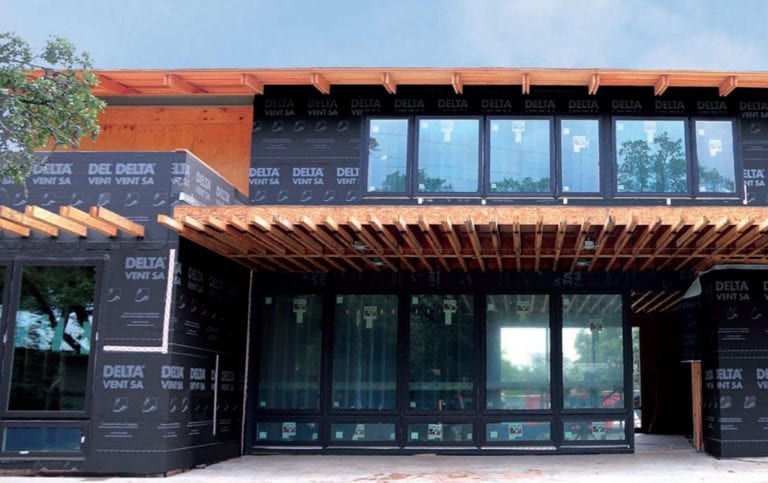In conventional low-slope roof assemblies, also known as exposed-membrane roof assemblies, the membrane is on the exterior of the roof insulation and structure, exposing it to exterior conditions including temperature, solar heat gains, night sky cooling, abrasion, and dirt. The type of insulation used in these assemblies and the color of the roof membrane can both have a significant impact on the performance of the roof. The choice of these materials can impact the energy transfer through the roof assembly, and subsequently the building energy consumption, as well as the durability of the roof membrane.
While insulation products are rated based on their thermal resistance according to a laboratory testing procedure, this test procedure does not necessarily reflect in-service conditions. The test procedure also does not consider the impacts of insulation thermal mass, roof temperatures, and potential latent heat transfer on the actual energy flows through roof assemblies.
Different roof membrane colors are also used in conventional roof assemblies. Reflective roof membranes are typically selected to increase reflection of solar radiation, thereby decreasing the roof membrane temperature and urban heat island effect. Often this color selection is a part of meeting green building program requirements. However, much of the work on reflective roofs does not consider the effects of soiling as roof membranes age, nor does it consider the actual heat transfers through roofs and the implications for building energy consumption.
Despite the relatively large impact of these factors on energy consumption, little work has been done on field performance.
The Project
We conducted an industry-sponsored research study with Soprema Inc., ROCKWOOL (formerly Roxul Inc.), and SMT Research to investigate the durability and thermal performance of conventional roof assemblies with respect to membrane color and insulation arrangement. A combination of laboratory, field, and modeling methods was used.
The field portion of the project consisted of a large-scale field monitoring program implemented in the Lower Mainland of British Columbia. A new conventional roof was installed on a test facility, using 3 different roof membrane colors (white, grey, and black) and 3 different insulation arrangements for a total of 9 unique roof assemblies. The 3 insulation arrangements were polyisocyanurate (polyiso) insulation, stone wool insulation, and a hybrid combination of the two consisting of a layer of stone wool installed above the polyiso insulation. Sensors were installed at key locations within each of the roof assemblies to measure temperature, relative humidity, moisture content, insulation movement, and heat flux.
To complement the field investigation work, the effective R-values of the insulation products were measured in the laboratory using the ASTM C518 protocol to measure actual R-values, including temperature and aging effects.
Finally, we performed whole-building energy modeling to account for the varying R-values of the insulation (as determined through the laboratory testing) and demonstrate the implications for building energy consumption. This modeling also allowed for the results of the study to be extrapolated to other climate zones across North America.
The Result
The laboratory measurements of the R-values of polyiso and stone wool insulation found that the R-value changed depending on temperature for both insulation types, though in different ways and amounts. When the results of these measurements were then used to calculate the apparent R-values of the roof assemblies, we determined that the polyiso roof assembly often provided reduced in-service performance compared to the hybrid and stone wool assemblies.
The field monitoring found that both these differences in the insulation’s in-service thermal performance and the different roof membrane colors led to different heat flows through the roof assemblies. We concluded that lighter-colored membranes and the more dimensionally stable stone wool insulation will likely provide improved membrane durability due to the decreased rate of roof temperature change and reduced peak temperatures.
Finally, whole building energy modeling of an ASHRAE archetypical commercial building found that the more stable apparent R-values provided by stone wool and hybrid insulation strategies lead to lower building energy consumption than polyiso, but that the optimal membrane color for energy efficiency will depend on climate. Typically, lighter membranes are most energy efficient in warmer, cooling-dominated climates, and darker membranes are more efficient in cold, heating-dominated climates. A summary of the results of this building energy modeling are provided in the figure below.
The results of this study were later published and presented at multiple conferences. Ultimately, understanding more about the factors that affect performance will help practitioners select the optimal membrane and insulation combination for more durable and energy-efficient roof assemblies.
Photographs courtesy of SMT Research.
Share This Post
Date:
May 6, 2019
Clients:
Soprema Inc., ROCKWOOL, SMT Research
Year Completed:
2014






